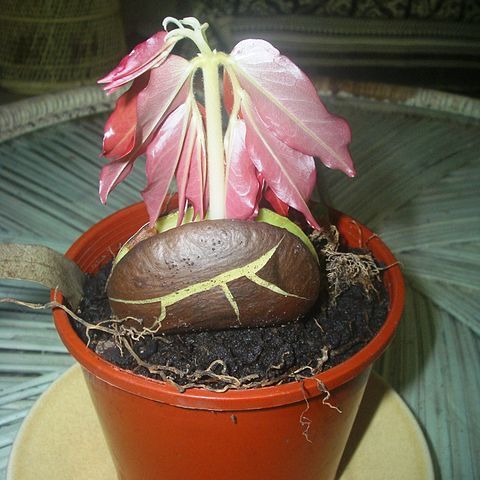Trees', growth flush-wise, the flushes developing from large buds. Buds covered by 2-ranked, brown, caducous bud scales with lengthwise veins; new leaves developing in bright white or pink tassels. Stipules present in the buds, very tender, caducous immediately after the unfolding of the bud, leaving hardly any scar. Leaves simply pinnate, (1-or) 2-15-jugate. Leaflets opposite, asymmetric and the midrib usually excentric and close to the upper margin; mostly glabrous. Inflorescences axillary, racemose, sessile, globular, contracted, dense, the rachis usually sturdy; bracts scale-like, veined lengthwise, lower ones broad reniform, gradually becoming ovate to lanceolate from halfway through the raceme, mostly persistent, appressed-hairy, glabrescent or not; bracteoles caducous, either linear, flat, small (not exceeding 5 mm), or larger (5-20 mm), obovate to spathulate, folded lengthwise with an apical tuft of hairs and usually a line of hairs along the dorsal side. Flowers bisexual. Hypanthium cupular and splitting under the developing fruit, or funnel-shaped (rarely tubular) enveloping the ovary and then splitting lengthwise as the fruit ripens. Sepals 4 (or 5), imbricate, reflexed at anthesis. Petals 5 (very occasionally some or all of them absent in M. brassii), narrow, free, glabrous. Disk absent. Stamens 15-80, filaments often connate at base, sometimes with a few hairs; anthers medi-dorsifix, lengthwise introrsely dehiscent, 1-2 mm long, very often separate below the insertion of the filament, mostly apiculate at apex. Ovary 1-(or 2-)ovuled, sessile or stipitate, the stipe usually central. Pods woody, ovoid, globose, sometimes oblong, or somewhat kidney-shaped, often compressed, indehiscent. Seeds globular, cotyledons smooth, semi-globular.
More
Unarmed trees; flushes of young leaves originating from large cone-shaped buds covered with imbricate, caducous bracts. Leaves simply pinnate; stipules deciduous; leaflets opposite or subopposite, in 1-15 pairs; midrib closer to one margin than the other. Inflorescence a dense, contracted, globular or ellipsoidal, sessile axillary raceme; axis usually thick; bracts mostly persistent. Flowers bisexual; bracteoles deciduous; receptacle campanulate and circumscissile, or tubular and splitting longitudinally as the fruit ripens. Sepals usually 4, imbricate. Petals 5, rarely absent. Stamens 15-80; filaments often connate basally; anthers longitudinally dehiscent. Ovary sessile or stalked. Fruit globose or ovoid, often compressed, woody, indehiscent. Seeds globular.

